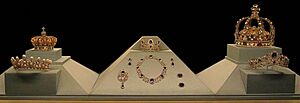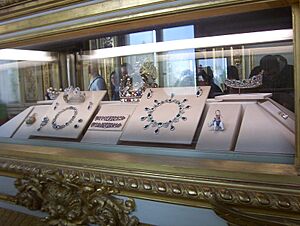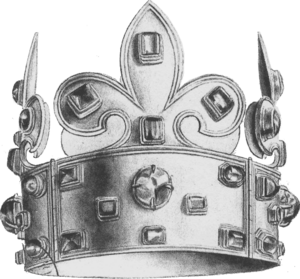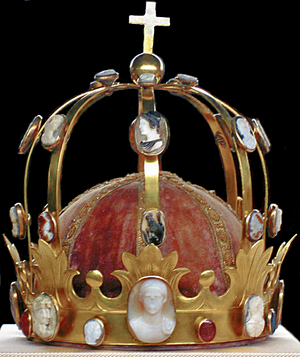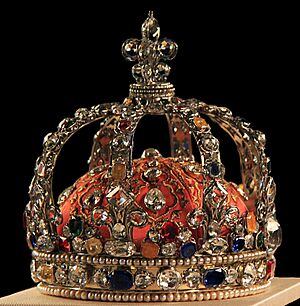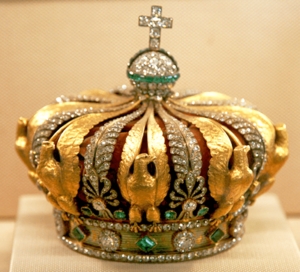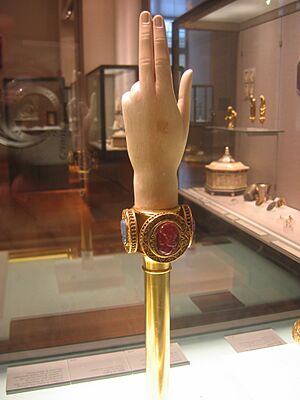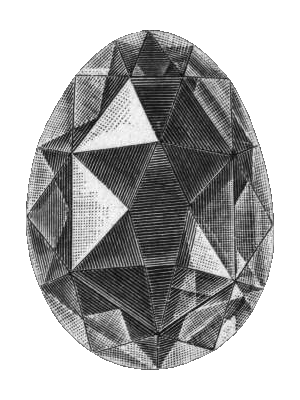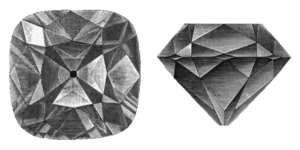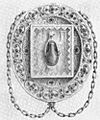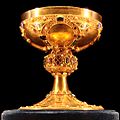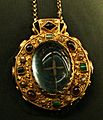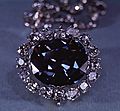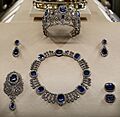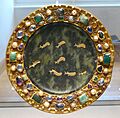French Crown Jewels facts for kids
The French Crown Jewels (in French: Joyaux de la Couronne de France) are a famous collection of crowns, sceptres, and jewels. For over 1,000 years, they were symbols of power for the kings, queens, and emperors of France, including Napoleon. Many of these treasures were worn during special ceremonies called coronations.
In 1885, the French government sold most of the jewels. The beautiful pieces that are left are now on display for everyone to see. You can find them in the Galerie d'Apollon at the Louvre, which is a famous museum in Paris that used to be a royal palace. The collection includes amazing gems like the Regent Diamond and the Sancy Diamond.
Some other jewels, like the Emerald of Saint Louis and the Ruspoli sapphire, are shown in the National Museum of Natural History in Paris.
Contents
Theft at the Louvre Museum
On October 19, 2025, a number of jewels were stolen from the Galerie d'Apollon at the Louvre. The museum had to close for the day because of the event. The police are investigating, and so far, only one item has been found. News reports suggest it might be the Crown of Empress Eugénie. The search for the other missing jewels continues.
What Were the Jewels Used For?
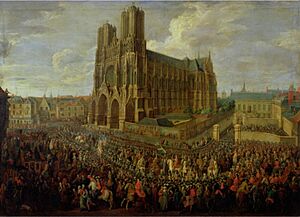
The Crown Jewels were most famously used during a special ceremony called a sacre, or coronation. This was when a new king or queen was officially crowned. The ceremony showed that the new ruler had the right to lead the country.
These important events usually took place in the beautiful Notre-Dame de Reims cathedral. The jewels, especially the crown, were powerful symbols of the monarch's authority. Over the centuries, different kings and queens added more jewels to the collection, making it bigger and more valuable.
After the French Revolution, coronations became rare. The last one was for King Charles X in 1825.
Famous Jewels in the Collection
While most of the original jewels were sold or lost, some of the most important pieces were saved and are now kept in the Louvre museum.
The Surviving Royal Crowns
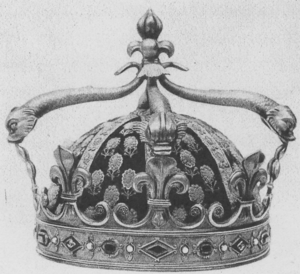
Over 20 royal crowns were made throughout French history, but most were destroyed during revolutions. Only a few survive today.
Crown of Louis XV
This is the only crown from the time of the French kings (the Ancien Régime) that still exists. It was made for King Louis XV and was decorated with famous diamonds, including the Regent Diamond and the Sancy Diamond.
When a king died, it was traditional to donate his crown to the treasury of the Basilica of St Denis. Before this crown was donated, the real diamonds were carefully removed and replaced with glass copies. The crown you can see today at the Louvre has these glass gems, but it is still a stunning piece of history.
Crown of Napoleon I
When Napoleon became Emperor of France in 1804, he had a new crown made. It was designed to look like the laurel wreaths worn by ancient Roman emperors. This crown was later destroyed in 1819. However, you can still see Napoleon's grand coronation throne at the Louvre.
Crown of Empress Eugénie
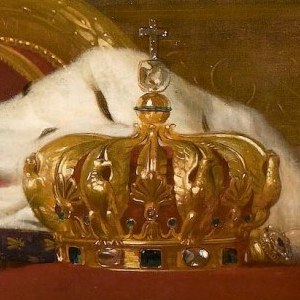
This beautiful crown was created in 1855 for Empress Eugénie, the wife of Napoleon III. She never had a formal coronation ceremony, but the crown was shown at a big world's fair in Paris. It is decorated with over 2,000 diamonds and 56 bright green emeralds.
Other Symbols of Power
Besides crowns, the collection includes other important items used by rulers.
The Coronation Sword, "Joyeuse"
The sword used to crown French kings is called Joyeuse, which means "joyful." Legend says it was the personal sword of the great king Charlemagne. The sword is very old, with parts dating from the 10th to the 13th centuries. During a coronation, it was held with the blade pointing up as a sign of power.
Sceptres and the Hand of Justice
A sceptre is a special staff held by a ruler during ceremonies. One of the oldest surviving pieces is the sceptre of King Charles V. It is over five feet long and has a small statue of Charlemagne on top.
Another unique French sceptre is the Main de Justice (Hand of Justice). It has a carving of an ivory hand on top, which was a symbol of the king's power to give justice to his people.
Famous Diamonds
The Louvre holds some of the world's most famous diamonds.
- The Regent Diamond is known for its perfect cut and amazing sparkle. It was once set in the crown of Louis XV and was also worn by Queen Marie Antoinette in a hat.
- The Sancy Diamond is a pale yellow diamond with a long history. It was even owned by the kings of England before coming to France.
- The Hortensia diamond is a beautiful pink diamond that was named after Hortense de Beauharnais, Queen of Holland and Napoleon's stepdaughter.
The Story of the Hope Diamond
One of the most famous gems from the collection is now called the Hope Diamond. It was originally a larger, deep-blue diamond called the Royal French Blue. It was stolen during the French Revolution in 1792 and disappeared.
Years later, a smaller blue diamond appeared that experts believe was cut from the original French Blue. This new diamond became known as the Hope Diamond. Many stories and legends say the diamond brought bad luck to its owners. Today, it is safely kept in the Smithsonian Institution in Washington, D.C., for everyone to see.
Why Were Most of the Jewels Sold?
In 1875, France became a republic (a country led by a president, not a king). The new government worried that some people might try to bring back a king.
In 1887, they decided to sell most of the Crown Jewels. The idea was that if there was no crown, there could be no king. One politician famously said, "Without a crown, no need for a king."
Most of the crowns, diadems, and jewels were sold to jewelers from around the world. Only a few pieces were kept for their historical importance. That is why the collection today is much smaller than it used to be.
Gallery
-
Joyeuse, the legendary sword of Charlemagne, kept at the Louvre.
-
This sceptre of Charles V has a small statue of Charlemagne on top.
-
The Hope Diamond, which was cut from the Royal French Blue after it was stolen in 1792.
See also
 In Spanish: Joyas de la Corona de Francia para niños
In Spanish: Joyas de la Corona de Francia para niños
- Treasury of Saint-Denis
- Regalia


